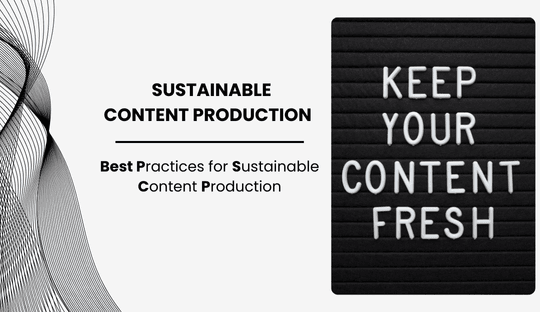
Best Practices for Sustainable Content Production
As the demand for digital content continues to grow, so does the need for sustainable content production practices. For creative brand companies like Flykez CO in Italy, adopting sustainable methods in content creation not only helps the environment but also enhances brand authenticity and meets consumer expectations for responsible business practices. Here are some best practices for sustainable content production that align with the latest content trends for 2024.
Understanding Sustainable Content Production
Sustainable content production involves creating digital content in a manner that minimizes environmental impact and promotes long-term ecological balance. This includes using eco-friendly tools, reducing digital waste, and ensuring the ethical use of resources.
1. Embrace Digital Content
Digital content inherently reduces the need for physical materials, such as paper and ink, thereby lowering the carbon footprint. By focusing on digital content, Flykez CO can significantly reduce its environmental impact. However, it’s important to manage digital resources efficiently to avoid excessive data consumption.
2. Optimize for SEO Content Production
Optimizing content for search engines (SEO) not only improves visibility but also promotes efficient use of resources. Effective SEO content production involves creating high-quality, relevant content that meets the needs of your audience. This reduces the need for excessive content creation and ensures that each piece of content reaches its maximum potential.
3. Prioritize Quality Over Quantity
In line with content trends for 2024, it’s crucial to prioritize quality over quantity. High-quality content is more likely to be shared, linked to, and retained, reducing the need for frequent content production. Focus on creating valuable, evergreen content that remains relevant over time.
4. Use Sustainable Tools and Platforms
Choose content creation tools and platforms that prioritize sustainability. This includes using cloud-based solutions with energy-efficient servers, opting for software that supports remote collaboration to reduce travel, and selecting platforms committed to reducing their carbon footprint.
5. Repurpose and Recycle Content
Repurposing existing content is a sustainable practice that maximizes the value of your efforts. For example, a well-researched blog post can be transformed into an infographic, a video, or a series of social media posts. This not only saves resources but also ensures consistent messaging across different platforms. Also Read About How to Optimize Content Production Workflow
6. Focus on Visual Content
Visual content, such as infographics and videos, is highly engaging and can convey complex information efficiently. However, it’s important to create visual content responsibly. Use digital tools for infographic design and video editing that support energy efficiency. Additionally, optimize visual content to reduce file sizes without compromising quality, thereby lowering data usage and storage requirements.
7. Implement Green Hosting Solutions
Web hosting services can have a significant environmental impact. Opt for green hosting solutions that use renewable energy sources and employ energy-efficient technologies. This ensures that your website and digital content are hosted sustainably, contributing to overall ecological balance.
8. Promote Sustainable Practices in Content Marketing
Educate your audience about sustainability and encourage them to adopt eco-friendly practices. This can include creating content that highlights the importance of sustainability, sharing tips on reducing digital waste, and promoting green initiatives. By integrating sustainability into your content marketing strategy, you build a responsible brand image and inspire positive change.
9. Measure and Improve
Regularly measure the impact of your content production practices and seek ways to improve. Use analytics tools to track resource usage, engagement, and the effectiveness of your sustainable practices. This data can guide future strategies and help you make informed decisions that further enhance sustainability.
10. Foster a Culture of Sustainability
Encourage a culture of sustainability within your organization. Educate employees about the importance of sustainable practices, provide training on eco-friendly tools and techniques, and recognize efforts that contribute to environmental responsibility. A committed team can drive significant progress toward sustainable content production.
Conclusion
Sustainable content production is not just a trend but a necessity for modern businesses. By embracing digital content, optimizing for SEO, prioritizing quality, using sustainable tools, repurposing content, focusing on visual content, implementing green hosting, promoting sustainable practices, measuring impact, and fostering a culture of sustainability, Flykez CO can lead the way in responsible content creation. These practices not only benefit the environment but also enhance brand reputation and meet the growing consumer demand for sustainable business practices.
For more information on how Flykez CO can help you implement sustainable content production, visit Flykez CO.
